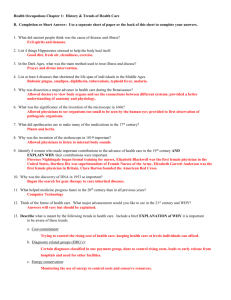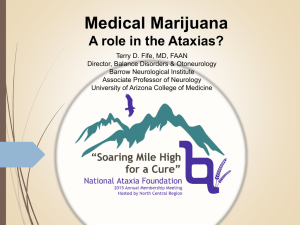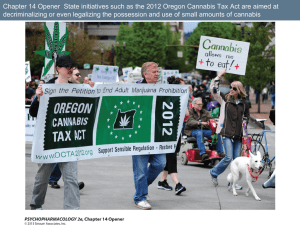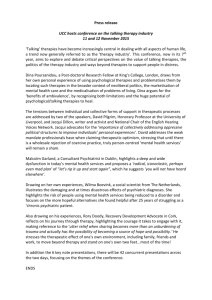complementary and alternative medicine for multiple sclerosis
advertisement
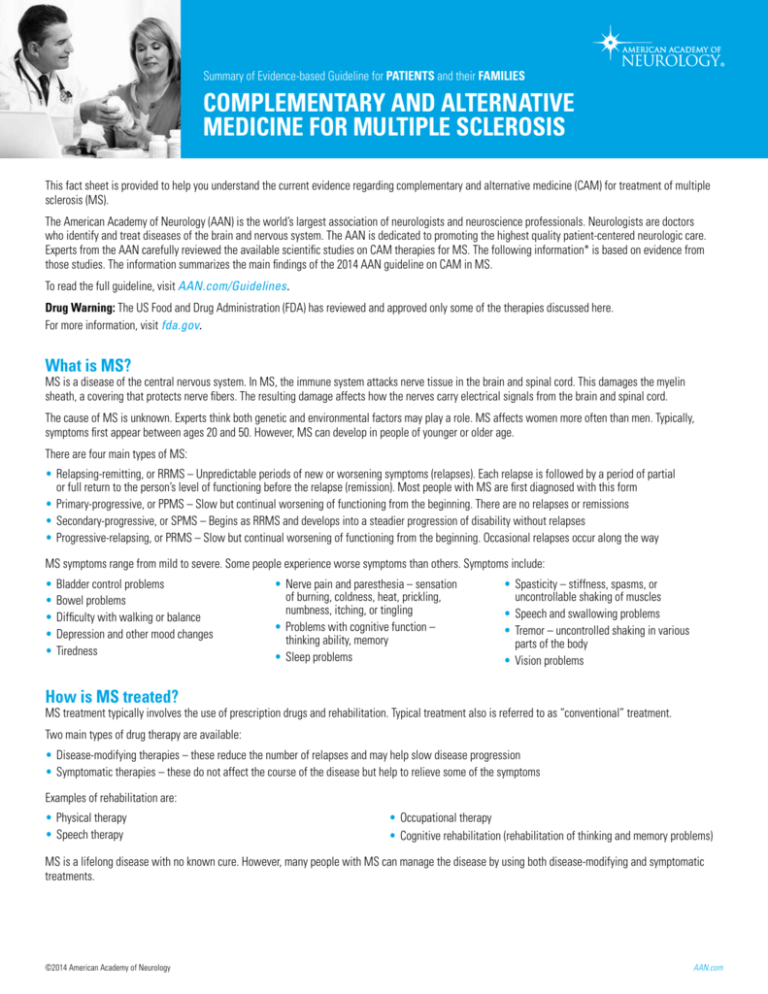
Summary of Evidence-based Guideline for PATIENTS and their FAMILIES COMPLEMENTARY AND ALTERNATIVE MEDICINE FOR MULTIPLE SCLEROSIS This fact sheet is provided to help you understand the current evidence regarding complementary and alternative medicine (CAM) for treatment of multiple sclerosis (MS). The American Academy of Neurology (AAN) is the world’s largest association of neurologists and neuroscience professionals. Neurologists are doctors who identify and treat diseases of the brain and nervous system. The AAN is dedicated to promoting the highest quality patient-centered neurologic care. Experts from the AAN carefully reviewed the available scientific studies on CAM therapies for MS. The following information* is based on evidence from those studies. The information summarizes the main findings of the 2014 AAN guideline on CAM in MS. To read the full guideline, visit AAN.com/Guidelines. Drug Warning: The US Food and Drug Administration (FDA) has reviewed and approved only some of the therapies discussed here. For more information, visit fda.gov. What is MS? MS is a disease of the central nervous system. In MS, the immune system attacks nerve tissue in the brain and spinal cord. This damages the myelin sheath, a covering that protects nerve fibers. The resulting damage affects how the nerves carry electrical signals from the brain and spinal cord. The cause of MS is unknown. Experts think both genetic and environmental factors may play a role. MS affects women more often than men. Typically, symptoms first appear between ages 20 and 50. However, MS can develop in people of younger or older age. There are four main types of MS: • Relapsing-remitting, or RRMS – Unpredictable periods of new or worsening symptoms (relapses). Each relapse is followed by a period of partial or full return to the person’s level of functioning before the relapse (remission). Most people with MS are first diagnosed with this form • Primary-progressive, or PPMS – Slow but continual worsening of functioning from the beginning. There are no relapses or remissions • Secondary-progressive, or SPMS – Begins as RRMS and develops into a steadier progression of disability without relapses • Progressive-relapsing, or PRMS – Slow but continual worsening of functioning from the beginning. Occasional relapses occur along the way MS symptoms range from mild to severe. Some people experience worse symptoms than others. Symptoms include: • Bladder control problems • Bowel problems • Difficulty with walking or balance • Depression and other mood changes • Tiredness • Nerve pain and paresthesia – sensation of burning, coldness, heat, prickling, numbness, itching, or tingling • Problems with cognitive function – thinking ability, memory • Sleep problems • Spasticity – stiffness, spasms, or uncontrollable shaking of muscles • Speech and swallowing problems • Tremor – uncontrolled shaking in various parts of the body • Vision problems How is MS treated? MS treatment typically involves the use of prescription drugs and rehabilitation. Typical treatment also is referred to as “conventional” treatment. Two main types of drug therapy are available: • Disease-modifying therapies – these reduce the number of relapses and may help slow disease progression • Symptomatic therapies – these do not affect the course of the disease but help to relieve some of the symptoms Examples of rehabilitation are: • Physical therapy • Speech therapy • Occupational therapy • Cognitive rehabilitation (rehabilitation of thinking and memory problems) MS is a lifelong disease with no known cure. However, many people with MS can manage the disease by using both disease-modifying and symptomatic treatments. ©2014 American Academy of Neurology AAN.com What is CAM therapy? How does it differ from usual MS treatment? CAM therapy is non-conventional treatment. This means it typically is not offered in a US hospital setting or prescribed by health care providers. However, some CAM therapies have long traditions in many parts of the world. CAM often is used with conventional treatment. However, sometimes it is used instead of conventional treatment. CAM includes a variety of therapies. These can be grouped as: • Mind-body medicine – for example, mindfulness training • Herbs or dietary supplements – for example, omega-3 fatty acids (fish oil) • Manipulative and body-based practices – for example, yoga, reflexology • Energy medicine – for example, magnetic therapy My doctor is treating my MS. Are there CAM therapies that can help me? This guideline reviewed studies of CAM therapies for treating MS. The authors examined the studies for evidence of safety and effectiveness. Overall, for most CAM therapies, there is little evidence that they are effective for treating MS. For some CAM therapies, no studies were available. For some other CAM therapies, studies showed evidence for effectiveness or lack of effectiveness. These are discussed next (see also the table below for a summary of the evidence). Ginkgo Biloba (GB) GB is an herbal therapy that comes from the ginkgo tree. GB extract can be taken as a pill. There is weak evidence* that GB helps lessen tiredness. However, strong evidence* shows GB does not improve thinking or memory problems. GB was well tolerated in all the studies reviewed here. However, studies of GB for other conditions noted an increased risk of bleeding. Talk to your doctor about bleeding risks before taking GB. Magnetic Therapy Magnetic therapy is a form of energy medicine. This therapy uses magnets on or near the skin. Magnets produce a magnetic force. This force is thought to improve functioning of the body. Moderate evidence* shows that magnetic therapy helps lessen tiredness. However, moderate evidence* also shows that this therapy does not help treat depression in MS. There is not enough evidence* to show whether magnetic therapy helps treat other MS symptoms.** Magnetic therapy may cause headache, spasms, and a burning sensation on the skin. Magnets may also interfere with medical devices such as pacemakers. Reflexology Reflexology is a form of body-based medicine. It involves applying manual pressure to points on the feet, hands, or ears. These points are thought to connect to the body’s organs and systems. Practitioners target certain points to help improve functioning of an organ or system. There is weak evidence* that reflexology helps treat paresthesia (a sense of tingling, numbness, or other unusual skin sensation). There is not enough evidence* to show whether reflexology helps treat other MS symptoms.** Bee Venom, Low-fat Diet, and the Cari Loder Regimen In bee sting therapy, multiple bee stings bring venom into the body. The venom is thought to fight inflammation. Weak evidence* shows bee sting therapy does not help treat MS symptoms** or slow the disease process. Bee sting therapy may cause mild to severe side effects. These include serious allergic reactions, serious infections, and death. Studies looked at the effect of a low-fat diet combined with fish oil. The fish oil contains omega-3 fatty acids. Moderate evidence* shows that this diet does not help treat MS symptoms** or improve quality of life. The Cari Loder regimen is a combination therapy of a prescription drug and dietary supplements. It includes lofepramine, a chemical related in structure to some antidepressants. The regimen also includes the amino acid L-phenylalanine and vitamin B12. There is weak evidence* that the Cari Loder regimen does not help treat MS symptoms.** Marijuana (Cannabis) Marijuana is an herb that grows naturally in the United States. It is also known as cannabis. Medical marijuana is cannabis used as medicine. Cannabis is a federally controlled substance. Until recently, it has been illegal to sell, possess/carry, or use. At this time, doctors can prescribe medical marijuana legally in 21 US states and Washington, DC. The studies looked at the effects of cannabis on symptoms of spasticity, pain, bladder problems, and tremor. Four forms of medical marijuana were studied: • Oral cannabis extract (OCE) – a cannabis pill • Synthetic tetrahydrocannabinol (THC) – a cannabis pill ©2014 American Academy of Neurology • Oromucosal cannabinoid spray – a spray used orally (by mouth) • Smoked cannabis AAN.com OCE and Synthetic THC OCE is taken orally (by mouth) in pill form. It consists of the chemical compounds tetrahydrocannabinol (THC) and cannabidiol. They also are called cannabinoids and come from the cannabis plant. These chemicals produce the effects of cannabis in the body. Synthetic THC is a human-made version of THC, a cannabinoid. It is available in pill form. At this time, two forms of marijuana have FDA approval: dronabinol (Marinol) and nabilone (Cesamet). Both drugs are synthetic forms of key ingredients in marijuana. The FDA approved dronabinol and nabilone as treatments for nausea and vomiting associated with cancer chemotherapy that do not respond to standard treatment. Dronabinol also is approved for loss of appetite associated with weight loss in patients with AIDS. At this time, the drugs are not approved for use in MS. Strong evidence* shows that OCE lessens patients’ reported symptoms of spasticity. It also lessens the pain caused by spasticity. Moderate evidence* shows that synthetic THC reduces patients’ reported symptoms of spasticity. It also reduces the pain caused by spasticity. There is moderate evidence* that both OCE and synthetic THC do not reduce tremor symptoms. There is not enough evidence to show whether OCE or synthetic THC help with bladder control. Oromucosal Cannabinoid Spray (Nabiximols) Oromucosal cannabinoid spray is medical marijuana taken orally (by mouth) in spray form. It is also known as nabiximols (Sativex). It has been approved for use only in Canada and parts of Europe. There is moderate evidence* that nabiximols can reduce: • Patients’ reported symptoms of spasticity • Pain caused by spasticity • Frequent urination Moderate evidence* also shows nabiximols does not treat loss of bladder control (incontinence). There is weak evidence* that nabiximols does not help relieve tremor. There is not enough evidence* to show whether nabiximols helps with other MS symptoms.** Smoked Cannabis There is not enough evidence* to show whether smoking cannabis is safe or effective for treating any MS symptoms. Important Concerns about Cannabis Most of the studies on cannabis were short-term. More studies are needed to show whether cannabis is safe long-term. Cannabis can cause side effects, and some can be serious. Some known side effects are: • Difficulty with attention and concentration • Dizziness • Drowsiness or tiredness • Dry mouth • Hallucinations (seeing or hearing things that are not there) • Increased spasticity • Loss of balance and falls • Nausea, vomiting, and constipation • Psychological problems such as depression and psychosis • Seizures • Thinking (cognition) and memory problems The potential for psychological problems are of particular concern. Some people with MS are at risk for depression or suicide. It is critical to discuss all these potential side effects with your doctor and weigh the benefits and risks of cannabis carefully. Many other CAM therapies have been studied for their effectiveness in MS. For some of these therapies, no studies were available. For other therapies, there was not enough evidence available to show whether the therapies were effective. General Concerns for CAM Therapies Most CAM therapies have not been reviewed and approved by the FDA, and their safety is unknown. There is not enough information to show whether any CAM therapies interfere with prescription drugs used to treat MS. Most CAM therapies are not covered by insurance. Work closely with your doctor to decide whether any CAM therapies would be good choices in your situation. If you are already using CAM therapies, talk to your doctor about whether evidence for those therapies is available. ©2014 American Academy of Neurology AAN.com Table: Evidence for Safety and Effectiveness of CAM Therapies Therapy Strength of Side Effects Seen in Studies Evidence GB Does not improve thinking ability (cognition) Strong Might help reduce tiredness Weak GB was well tolerated in all studies reviewed. However, studies of GB for other conditions noted an increased risk of bleeding. Talk to your doctor about bleeding risks before taking GB Moderate None Moderate Most studies reported no negative side effects. One study reported headache, spasms, and burning sensation Weak Some of the side effects reported in some studies: • Constipation • Dry mouth • Insomnia • Nausea Weak None Weak Bee stings can be associated with allergic reaction and possible death. Other side effects include: • Tenderness, swelling, and redness at the sting sites • Itching • Flu-like symptoms Strong Some of the side effects reported in some studies: • Difficulty with attention and concentration • Dizziness • Drowsiness or tiredness • Dry mouth • Increased spasticity • Loss of balance and falls • Nausea, vomiting, and constipation • Psychological problems such depression and psychosis • Thinking and memory problems Low-fat Diet with Omega-3 Fatty Acids (Fish Oil) Probably does not help lessen MS symptoms or relapses Magnetic Therapy Probably helps reduce tiredness Probably does not help reduce depression Cari Loder Regimen Might not help improve MS symptoms Reflexology Might help reduce paresthesia (uncomfortable skin sensations) Bee Sting Therapy Might not help improve MS symptoms Medical Marijuana (Cannabis) OCE and Synthetic THC (in Pill Form) OCE: • Can reduce patients’ reported symptoms of spasticity • Can lessen pain due to spasticity (but not nerve pain) Moderate Synthetic THC: • Can probably reduce patients’ reported symptoms of spasticity short-term (15 weeks) but probably does not lead to improvement short-term on tests for spasticity a doctor performs • Can probably lessen pain due to spasticity (but not nerve pain) OCE and synthetic THC: • Probably do not reduce tremor symptoms Moderate Weak OCE and synthetic THC: • Might reduce patients’ reported spasticity long-term (one year) • Might reduce pain from spasticity long-term (one year) OCE and THC: • Not enough evidence to show that these help reduce bladder problems Unknown Synthetic THC (Marinol): • Not enough evidence to show that this helps lessen nerve pain Unknown ©2014 American Academy of Neurology AAN.com Oromucosal Cannabinoid Spray (Nabiximols) • Probably helps treat patients’ reported spasticity symptoms • Probably helps lessen pain from spasticity • Probably helps lessen frequent urination • Probably does not lead to improvement short-term on tests for spasticity a doctor performs • Probably does not treat loss of bladder control (incontinence) Moderate • Might not help lessen tremor Weak Not enough evidence to show whether this helps with: • Anxiety • Tiredness • Overall bladder problems • Quality of life • Sleep problems • Thinking ability (cognition) Unknown Dizziness was the most common negative side effect. Other side effects include: • Confusion • Disorientation • Hallucination (seeing or hearing things that are not there) • Low mood • Possible negative effect on long-term memory Smoked Cannabis Not enough evidence to show whether smoked cannabis is safe or helpful for treating MS symptoms Unknown Negative side effects similar to those reported in studies of other cannabis forms. Also include: • Tiredness • Feeling “too high” • Headache • Nausea This guideline was endorsed by the Consortium of Multiple Sclerosis Centers and the International Organization of Multiple Sclerosis Nurses. This statement is provided as an educational service of the American Academy of Neurology. It is based on an assessment of current scientific and clinical information. It is not intended to include all possible proper methods of care for a particular neurologic problem or all legitimate criteria for choosing to use a specific procedure. Neither is it intended to exclude any reasonable alternative methodologies. The AAN recognizes that specific patient care decisions are the prerogative of the patient and the physician caring for the patient, based on all of the circumstances involved. *After the experts review all of the published research studies, they describe the strength of the evidence supporting each recommendation: Strong evidence = more than one high-quality scientific study Moderate evidence = at least one high-quality scientific study or two or more studies of a lesser quality Weak evidence = the studies, while supportive, are weak in design or strength of the findings Not enough evidence = either different studies have come to conflicting results or there are no studies of reasonable quality ** See the published guideline for the specific symptoms noted in the studies. The AAN develops these summaries as educational tools for neurologists, patients, family members, caregivers, and the public. You may download and retain a single copy for your personal use. Please contact guidelines@aan.com to learn about options for sharing this content beyond your personal use. American Academy of Neurology, 201 Chicago Avenue, Minneapolis, MN 55415 Copies of this summary and additional companion tools are available at AAN.com or through AAN Member Services at (800) 879-1960. ©2014 American Academy of Neurology AAN.com

